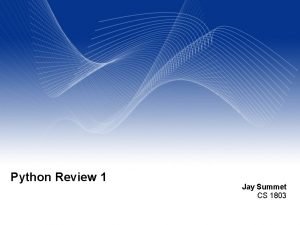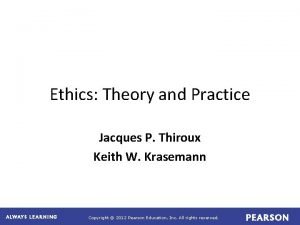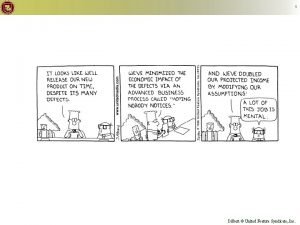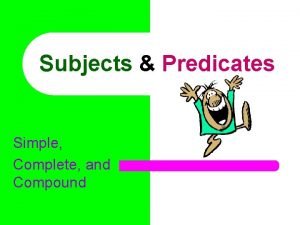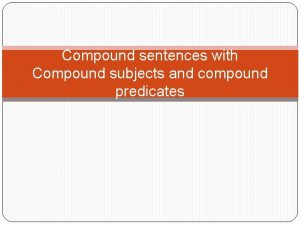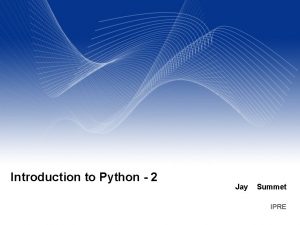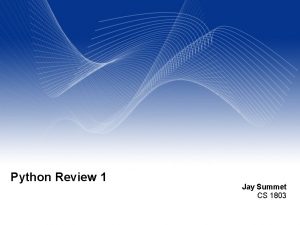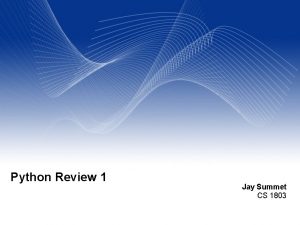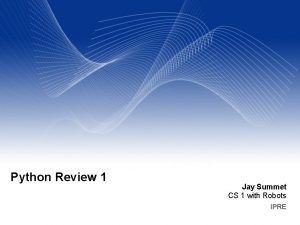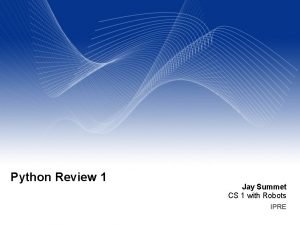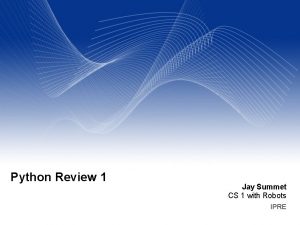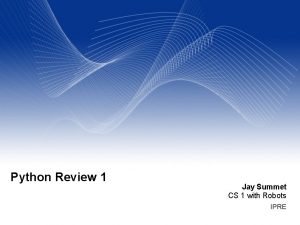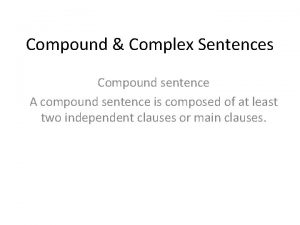Python Review 2 Jay Summet IPRE Outline Compound










![Slices – Default values for blanks SEQUENCE_VAR [ START : END ] my. String Slices – Default values for blanks SEQUENCE_VAR [ START : END ] my. String](https://slidetodoc.com/presentation_image/2b999202f5b0ce14142fafcac4c03c77/image-11.jpg)

















- Slides: 28

Python Review 2 Jay Summet IPRE

Outline Compound Data Types: Strings, Tuples, Lists & Dictionaries Immutable types: Strings Tuples Accessing Elements Cloning Slices Mutable Types: Lists Dictionaries Aliasing vs Cloning 2

Compound Data Types - A data type in which the values are made up of elements that are themselves values. Strings – Enclosed in Quotes, holds characters, (immutable): “This is a String” Tuples – Values separated by commas, (usually enclosed by parenthesis) and can hold any data type (immutable): (4 , True, “Test”, 34. 8) Lists – Enclosed in square brackets, separated by commas, holds any data type (mutable): [4, True, “Test”, 34. 8] Dictionaries – Enclosed in curly brackets, elements separated by commas, key : value pairs separated by colons, keys can be any immutable data type, values can be any data type: { 1 : “I”, 2 : ”II”, 3 : “III”, 4 : “IV”, 5 : “V” } 3

Immutable Types Strings and Tuples are immutable, which means that once you create them, you can not change them. The assignment operator (=) can make a variable point to strings or tuples just like simple data types: my. String = “This is a test” my. Tuple = (1, 45. 8, True, “String Cheese”) Strings & Tuples are both sequences, which mean that they consist of an ordered set of elements, with each element identified by an index. 4

Accessing Elements my. String = “This is a test. ” You can access a specific element using an integer index which counts from the front of the sequence (starting at ZERO!) my. String[0] produces 'T' my. String[1] produces 'h' my. String[2] produces 'i' my. String[3] produces 's' The len() function can be used to find the length of a sequence. Remember, the last element is the length minus 1, because counting starts at zero! my. String[ len(my. String) – 1] produces '. ' 5

Counting Backwards my. String = “This is a test. ” As a short cut (to avoid writing len(my. String) ) you can simply count from the end of the string using negative numbers: my. String[ len(my. String) – 1 ] produces '. ' my. String[-1] also produces '. ' my. String[-2] produces 't' my. String[-3] produces 's' my. String[-4] produces 'e' 6

Index out of Range! my. String = “This is a test. ” Warning! If you try to access an element that does not exist, Python will throw an error! my. String[5000] produces An ERROR! my. String[-100] produces An ERROR! 7

Traversals Many times you need to do something to every element in a sequence. (e. g. Check each letter in a string to see if it contains a specific character. ) Doing something to every element in a sequence is so common that it has a name: a Traversal. You can do a traversal using a while loop as follows: index = 0 while ( index < len (my. String) ): if my. String[index] == 'J': print “Found a J!” index = index + 1 8

Easy Traversals – The FOR Loop Python makes traversals easy with a FOR loop: for ELEMENT_VAR in SEQUENCE: STATEMENT A for loop automatically assigns each element in the sequence to the (programmer named) ELEMENT_VAR, and then executes the statements in the block of code following the for loop once for each element. Here is an example equivalent to the previous WHILE loop: for my. Var in my. String: if my. Var == 'J': print “I found a J!” Note that it takes care of the indexing variable for us. 9

Grabbing Slices from a Sequence The slice operator will clip out part of a sequence. It looks a lot like the bracket operator, but with a colon that separates the “start” and “end” points. SEQUENCE_VAR [ START : END ] my. String = “This is a test. ” my. String[0: 2] produces 'Th' (0, 1, but NOT 2) my. String[3: 6] produces 's i” (3 -5, but NOT 6) POP QUIZ: my. String[ 1 : 4 ] my. String[ 5: 7 ] produces ? ? 10
![Slices Default values for blanks SEQUENCEVAR START END my String Slices – Default values for blanks SEQUENCE_VAR [ START : END ] my. String](https://slidetodoc.com/presentation_image/2b999202f5b0ce14142fafcac4c03c77/image-11.jpg)
Slices – Default values for blanks SEQUENCE_VAR [ START : END ] my. String = “This is a test. ” If you leave the “start” part blank, it assumes you want zero. my. String[ : 2] produces 'Th' (0, 1, but NOT 2) my. String[ : 6] produces 'This i' (0 -5, but NOT 6) If you leave the “end” blank, it assumes you want until the end of the string my. String[ 5 : ] produces 'is a test. ' (5 – end) my. String [ : ] end) produces 'This is a test. ' (011

Using Slices to make clones (copies) You can assign a slice from a sequence to a variable. The variable points at a copy of the data. my. String = “This is a test. ” his. String = my. String [ 1 : 4 ] is. String = my. String [ 5 : 7 ] test. String = my. String [10 : ] 12

Tuples can hold any type of data! You can make one by separating some values with comas. Convention says that we enclose them with parenthesis to make the beginning and end of the tuple explicit, as follows: (4, True, “Test”, 14. 8) NOTE: Parenthesis are being overloaded here, which make the commas very important! (4) is NOT a tuple (it's a 4 in parenthesis) (4, ) IS a tuple of length 1 (note the trailing comma) Tuples are good when you want to group a few variables together (first. Name, last. Name) (x, y) 13

Using Tuples to return multiple pieces of data! Tuples can also allow you to return multiple pieces of data from a function: def area_volume_of_cube( side. Length): area = 6 * side. Length volume = side. Length * side. Length return area, volume my. Area, my. Volume = area_volume_of_cube( 6 ) Note that in this example we left out the (optional) parenthesis from the tuple (area, volume)! You can also use tuples to swap the contents of two variables: a, b = b, a 14

Tuples are sequences! Because tuples are sequences, we can access them using the bracket operator just like strings. my. Tuple = ( 4, 48. 8, True, “Test”) my. Tuple[0 ] my. Tuple[ 1 ] my. Tuple[ 2 ] my. Tuple[ -1 ] produces 48. 8 produces. True produces'Test' 15

“Changing” Immutable data types can not be changed after they are created. Examples include Strings and Tuples. Although you can not change an immutable data type, you can create a new variable that has the changes you want to make. For example, to capitalize the first letter in this string: my. String = “all lowercase. ” my. New. String = “A” + my. String[1: ] We have concatenated two strings (a string with the capital letter A of length 1, and a clone of my. String missing the first, lowercase, 'a'). 16

Changing mutable data types Mutable data types can be changed after they are created. Examples include Lists and Dictionaries. These changes happen “in place”. my. List = ['l', 'o', 'w', 'e', 'r', 'c', 'a', 's', 'e'] my. List[0] = 'L' print my. List produces: [ 'L', 'o', 'w', 'e', 'r', 'c', 'a', 's', 'e'] Note that we are using the indexing operator [brackets] in the same way that we always have, but when combined with the assignment operator (=) it replaces the element at index 0 with the 'L'. 17

Lists – like strings & tuples, but mutable! Lists are a mutable data type that you can create by enclosing a series of elements in square brackets separated by commas. The elements do not have to be of the same data type: my. List = [ 23, True, 'Cheese”, 3. 1459 ] Unlike Strings and tuples, individual elements in a list can be modified using the assignment operator. After the following commands: my. List[0] = True my. List[1] = 24 my. List[3] = “Boo” my. List contains: [ True, 24, 'Cheese', 'Boo' ] 18

Different Elements, Different Types Unlike strings, which contain nothing but letters, list elements can be of any data type. my. List = [ True, 24, 'Cheese', 'Boo' ] for each. Element in my. List: print type(each. Element) produces: <type 'bool'> <type 'int'> <type 'str'> 19

List Restrictions and the append method Just like a string, you can't access an element that doesn't exist. You also can not assign a value to an element that doesn't exist. Lists do have some helper methods. Perhaps the most useful is the append method, which adds a new value to the end of the list: my. List = [ True, 'Boo', 3] my. List. append(5) print my. List [ True, 'Boo', 3, 5] 20

And now, for something completely different! Dictionaries are an associative data type. Unlike sequences, they can use ANY immutable data type as an index. Dictionaries will associate a key (any immutable data), with a value (any data). For example, we can use a dictionary to associate integer keys (the numbers 1 -5) with strings (their Roman numeral representation) like this: arabic 2 roman = { 1 : “I”, 2 : ”II”, 3 : “III”, 4 : “IV”, 5 : “V” } 21

Dictionary example: Accessing arabic 2 roman = { 1 : “I”, 2 : ”II”, 3 : “III”, 4 : “IV”, 5 : “V” } You can retrieve a value from a dictionary by indexing with the associated key: arabic 2 roman[1] produces 'I' arabic 2 roman[5] produces 'V' arabic 2 roman[4] produces 'IV' 22

Reassigning & Creating new Key/Value associations arabic 2 roman = { 1 : “I”, 2 : ”II”, 3 : “III”, 4 : “IV”, 5 : “V” } You can assign new values to existing keys: arabic 2 roman [1] = 'one' now: arabic 2 roman[1] produces 'one' You can create new key/value pairs: arabic 2 roman[10] = 'X' now arabic 2 roman[10] produces 'X' 23

Dictionaries and default values with the get method If you use an index that does not exist in a dictionary, it will raise an exception (ERROR!) But, you can use the get( INDEX, DEFAULT) method to return a default value if the index does not exist. For example: arabic 2 roman. get(1, ”None”) produces 'I' arabic 2 roman. get(5, “None”) produces 'V' arabic 2 roman. get(500, “None”) produces 'None' arabic 2 roman. get(“test”, “None”) produces 'None' 24

Difference Between Aliases & Clones More than one variable can point to the same data. This is called an Alias. For example: a = [ 5, 10, 50, 100] b = a Now, a and b both point to the same list. If you make a change to the data that a points to, you are also changing the data that b points to: a[0] = 'Changed' a points to the list: [“Changed”, 10, 50, 100] But because b points to the same data, b also points to the list ['Changed', 10, 50, 100] 25

Cloning Data with the Slice operator If you want to make a clone (copy) of a sequence, you can use the slice operator ( [: ] ) For example: a = [ 5, 10, 50, 100] b = a[0: 2] Now, b points to a cloned slice of a that is [ 5, 10] If you make a change to the data that a points to, you do NOT change the slice that b points to. a[0] = 'Changed' a points to the list: [“Changed”, 10, 50, 100] b still points to the (different) list [5, 10] 26

Cloning an entire list You can use the slice operator with a default START and END to clone an entire list (make a copy of it) For example: a = [ 5, 10, 50, 100] b = a[: ] Now, a and b point to different copies of the list with the same data values. If you make a change to the data that a points to, nothing happens the list that b points to. a[0] = 'Changed' a points to the list: [“Changed”, 10, 50, 100] b points to the copy of the old a: [ 5, 10, 50, 100] 27

Be very careful! The only difference in the above examples was the use of the slice operator in addition to the assignment operator: b = a vs b = a[: ] This is a small difference in syntax, but it has a very big semantic meaning! Without the slice operator, a and b point to the same list. Changes to one affect the other. With it, they point to different copies of the list that can be changed independently. 28
 Jay summet
Jay summet Jay summet
Jay summet Flow summet
Flow summet Jacques thiroux morality
Jacques thiroux morality Ipre
Ipre Ipre
Ipre What is sentence outline
What is sentence outline Pauline and bruno have a big argument
Pauline and bruno have a big argument Simple vs compound subject
Simple vs compound subject Compound complex sentence quiz
Compound complex sentence quiz Compound subjects
Compound subjects A compound differs from an element in that a compound
A compound differs from an element in that a compound A compound differs from an element in that a compound
A compound differs from an element in that a compound Python quick review
Python quick review Chapter review motion part a vocabulary review answer key
Chapter review motion part a vocabulary review answer key Writ of certiorari ap gov example
Writ of certiorari ap gov example Nader amin-salehi
Nader amin-salehi Prisma diagram example
Prisma diagram example Narrative review vs systematic review
Narrative review vs systematic review Glad you joined us
Glad you joined us Jay haley strategic family therapy
Jay haley strategic family therapy 688800700
688800700 Academic advisement john jay
Academic advisement john jay Symbols in the great gatsby
Symbols in the great gatsby Jay barney competitive advantage
Jay barney competitive advantage The great gatsby questions
The great gatsby questions York university myanmar
York university myanmar Kaley jay terry
Kaley jay terry Jay kriner
Jay kriner


